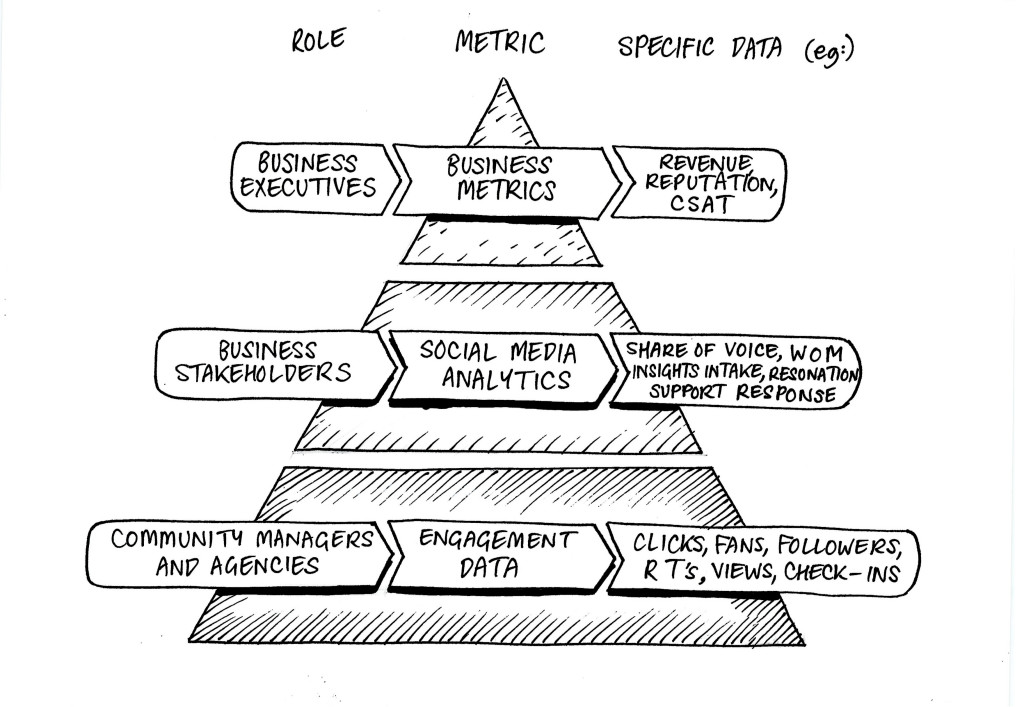Top 10 management models for your business #6: Social media ROI pyramid
13 August 2014 by Infinite Ideas in 100+ Management Models, Business and finance
Fons Trompenaars and Piet Hein Coebergh, co-authors of 100+ Management Models.
Problem statement
How can one measure the return on investment (ROI) of social media?
Essence
Return on investment (ROI) is a key concept in business, describing when an investment will be gained back. For investments in social media, Jeremiah Owyang, management consultant at Altimeter, developed a hierarchy of metrics, depicted above, to merge various forms of metrics for social media, serving various stakeholders in different roles. This model attempts to fulfil the need of an increasing number of organizations that find it difficult to define critical success factors and key performance indicators for online communications in general and social media in particular.
Owyang proposes distinguishing different, but related, metrics for different layers in an organization:
- Business metrics, for executives (and ‘everyone else who supports them’), summarizing the social media analytics;
- Social media analytics, for the managers and employees who are strongly engaged in social media, focusing on how social media impacts business;
- Engagement data, for community managers and communications agencies, measuring the social footprint in detail (e.g. in clicks, followers, likes, retweets, views, etc.).
How to use the model
Owyang proposes five steps to start using the ROI Pyramid:
- Start with a business goal in mind: expect significant challenges to occur if your social media efforts don’t have a business goal. It’s easy to spot when this happens, as the goal will be getting ‘more fans and followers’ rather than moving the business needle forward.
- Give the right data to the right roles: not all roles require the same types of data; be sure to give the right type of data to the right segment. While all the formulae of the pyramid should be accessible by the corporation, understand the viewpoints needed from each vantage point.
- Tailor the frequency and quantity of data along pyramid tiers: recognize that executives need reports less frequently than the deployment teams, hence their size on the pyramid. Also, there is more data needed at the bottom tiers than at the top; remember the top tiers are roll-up formulae from bottom tiers.
- Customize formulae: as long as there are no standards in measuring social media, there is no need to wait for them.
- Benchmark over time and cascade to all layers of the organization. Note that the specific numbers aren’t as important as the trend lines over time.
In addition, Owyang found that organizations apply ‘six ways of measuring the revenue impact of social media’, of which three are top-down: anecdotes, correlations and multivariate testing. The other three are bottom-up: measuring the ‘clicks’ (see also under ‘engagement data’ above), using integrated software and measuring e-commerce.
Results
Applying the model may result in developing an overall dashboard for the organization to monitor progress of a company’s conversation strategy, or it can be used to help define which metrics need further refinement and how they connect with other metrics (as, for instance, used in a balanced scorecard) that measure success in corporate communications.
Comments
Measuring the effect of communications has been a challenge for as long as communications have been studied. John Wanamaker, a pioneer of marketing in the nineteenth century, said: ‘Half the money I spend on advertising is wasted; the trouble is, I don’t know which half.’ Some critics argue that science hasn’t made much improvement since. Especially in online communications, trial and error is inevitable in making progress along the new frontiers of global communications. Measuring the plans and results will at least contribute to learning from mistakes and, at best, guide the organization into the envisioned future.
Literature
Blanchard, O. (2011) Social Media ROI: Managing and Measuring Social Media Efforts in your Organization, Boston, Pearson Education.
Broom, D., McCann, M., Bromby, M.C., Barlow, A. (2011) Return on Investment: What Literature Exists on the Use of Social Media and ROI? Available online at Social Science Research Network.
Kelly, N. (2013) How to Measure Social Media: A Step-by-Step Guide to Developing and Assessing Social Media ROI, Boston, Pearson Education.


